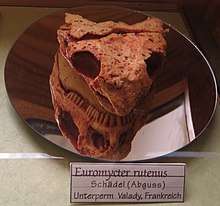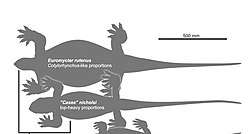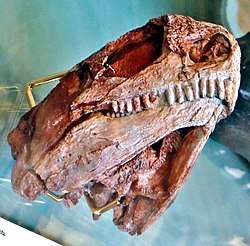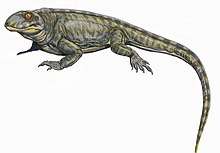Euromycter
Euromycter is an extinct genus of medium-sized caseid synapsids from Early (Artinskian-Kungurian) or Middle (Roadian-Wordian) Permian deposits of Southern France. The holotype and only known specimen of Euromycter (MNHN.F.MCL-2) includes the complete skull with lower jaws and hyoid apparatus, six cervical vertebrae with proatlas, anterior part of interclavicle, partial right clavicle, right posterior coracoid, distal head of right humerus, left and right radius, left and right ulna, and complete left manus. It was collected by D. Sigogneau-Russell and D. Russell in 1970 at the top of the M1 Member, Grès Rouge Group, near the village of Valady (département of Aveyron), Rodez Basin. It was first assigned to the species "Casea" rutena by Sigogneau-Russell and Russell in 1974. More recently, it was reassigned to its own genus, Euromycter, by Robert R. Reisz, Hillary C. Maddin, Jörg Fröbisch and Jocelyn Falconnet in 2011.[1] The preserved part of the skeleton suggests a size between 1,70 m (5,5 ft) and 1,80 m (5,9 ft) in length for this individual.[2]
| Euromycter | |
|---|---|
 | |
| Skull cast | |
| Scientific classification | |
| Kingdom: | Animalia |
| Phylum: | Chordata |
| Clade: | †Caseasauria |
| Family: | †Caseidae |
| Genus: | †Euromycter Reisz et al., 2011 |
| Species | |
| Synonyms | |
| |
Etymology
The generic name refers to the location of the taxon in Europe, and “mycter” = nose, refers to the enlarged external naris that characterizes the caseids.[1] The species epithet refers to ruteni (Les Rutènes in French) the Latin name of the Gallic tribe that lived in the Rodez area.[3]
Description

The skull is well-preserved but has suffered of a slight flattening as a result of a tectonic thrust exerted toward the right side and the front. As in other caseid, the skull is small compared to the skeleton (here mainly the forelimbs), and shows very large external nares, a short facial region, and a dorsal surface of the skull dotted of numerous small depressions. In addition, they are many palatal teeth, and the teeth of the upper jaws are numerous (four premaxillary and eleven maxillary teeth) and spatulate with many cuspids.[3] The front teeth, fairly long and slightly recurved, were probably suited to aid in gathering vegetation into the mouth, whereas it is presumed that palatal teeth had to worked in conjunction with a tough and massive muscular tongue as indicated by the presence of a very well-developed hyoid apparatus.[4][5]
Characteristically, Euromycter shows an unusually broad skull, large temporal fenestra, and lack of expansion of the axial neural spine. It can be distinguished from other caseids by the presence of a supernumerary blade-like intranarial bone located posteromedially to the septomaxilla, proportional differences in forelimb and manus, presence of an accessory proximal articulation between metacarpals 3 and 4, medial recurvature of metacarpal, and its manual phalangeal formula of 2-3-4-4-3.[3][1]
Stratigraphic range

The holotype of Euromycter comes from the top of the red pelitic beds of the M1 Member, in the basal part of the Grès Rouge (“Red Sandstone”) Group, a sedimentary sequence subdivided into five hectometric members (M1 to M5) localized in the western Rodez basin. The deposits are interpreted as a playa-lake environment (or Sabkha) under a semi-arid, hot climate.[1] The age of the Grès Rouge Group is uncertain but it is regarded as contemporaneous to the Saxonian Group of the neighbourhing Lodève basin, where radiometric and magnetostratigraphic data suggested previously an age between the late Sakmarian (middle of the Early Permian) and the early Lopingian (early Late Permian).[6][1] However, new chronostratigraphic and magnetostratigraphic data for the Saxonian Group indicate an age between the Artinskian (for the Rabejac Formation and the Octon Member of the Salagou Formation) and the Roadian-Wordian (for La Lieude Formation).[7][8] Unfortunately, there is no evidence for a more precise correlation of the M1 to M5 members of the Grès Rouge Group with the Rabejac, Salagou and La Lieude formations of the Saxonian Group.[1] So the age of Euromycter is somewhere between the late Early Permian and the early to mid-Middle Permian. It’s only possible to say that it comes from older rocks than Ruthenosaurus, another caseid found in the same area.
Discovery

During a prospecting survey carried out in the Permian red sandstones outcropping in badlands on the western flank of the Cayla Hill (commune of Valady, northwest of Rodez), the paleontologists Denise Sigogneau-Russell and Donald Eugene Russell discovered in the summer of 1970 the skeletons of two herbivorous reptiles. An eroded vertebra picked up on the western slope of the hill led the scientists to explore the surrounding canyons where they discovered a large articulated skeleton still in place in the sediments but damaged by erosion. The skull, neck, most of the limbs, and the tail had been washed away and destroyed. On the southeastern flank of the same hill, the same team discovered a bone fragment from a different animal. The systematic exploration of surrounding slopes permits the discovery of bones still in place in the rock belonging to a smaller animal than the first. The whole back of the skeleton had already destroyed by erosion. The right forearm was exposed at the surface of the rock, then was found the skull, several articulated cervical vertebrae, the left forearm articulated with the complete left manus, a piece of the right humerus and parts of the right shoulder. Both specimens were identified as caseids pelycosaurs. The smaller specimen found at about two kilometers horizontally from the first skeleton, but 120 meters lower stratigraphically, was described in 1974 and assigned to a new species of the genus Casea, Casea rutena. This animal was celebrated as the first caseid found in Western Europe, making of this species a geographical link with other specimens of the family that were previously known only in the south central United States (Texas and Oklahoma) and in the northern European Russia.[3]
In 2008, a phylogenetic analysis of Caseidae demonstrates the paraphyly of the genus Casea, the French species representing a distinct unnamed genus.[9] Three years later, the species Casea rutena was removed of the genus Casea and assigned to a new genus, Euromycter, in the new combination Euromycter rutenus. In the same article the authors described the larger and stratigraphycally younger skeleton from the Cayla Hill, and assigned it to a new genus named Ruthenosaurus.[1]
Classification
In the first phylogenetic analysis of the caseids published in 2008, Euromycter, then still designated as “Casea” rutena, was recovered as the sister taxon to a derive clade containing Ennatosaurus tecton, Cotylorhynchus romeri and Angelosaurus dolani.
Below the first phylogenetic analysis of Caseidae published by Maddin et al. in 2008.[9]
| Caseasauria |
| ||||||||||||||||||||||||||||||||||||
A phylogenetic analysis made by Benson shows a similar position for Euromycter (again regarded as “Casea” rutena).
Below the phylogenetic analysis of Caseasauria published by Benson in 2012.[10]
| Caseasauria |
| ||||||||||||||||||||||||||||||||||||||||||||||||||||||||||||
In 2015, Romano & Nicosia found a similar position for Euromycter in their most parsimonious analysis including nearly all caseids (to the exclusion of the very fragmentary Alierasaurus ronchi from Sardinia).
Below the most pasimonious phylogenetic analysis published by Romano & Nicosia in 2015.[11]
| Caseasauria |
| ||||||||||||||||||||||||||||||||||||||||||||||||||||||||||||||||||||||||||||||
References
- Reisz, R.R.; Maddin, H.C.; Fröbisch, J.; Falconnet, J. (2011). "A new large caseid (Synapsida, Caseasauria) from the Permian of Rodez (France), including a reappraisal of "Casea" rutena Sigogneau-Russell & Russell, 1974". Geodiversitas. 33 (2): 227–246.
- Spindler F., Falconnet J. and Fröbisch J. (2016). Callibrachion and Datheosaurus, two historical and previously mistaken basal caseasaurian synapsids from Europe. Acta Palaeontologica Polonica 61. doi:10.4202/app.00221.2015.
- Sigoneau-Russell, D.; Russel, D.E. (1974). "Étude du premier caséidé (Reptilia, Pelycosauria) d'Europe occidentale". Bulletin du Muséum national d'Histoire naturelle Série 3. 38 (230): 145–215.
- Olson, E.C. (1968). "The family Caseidae". Fieldianna (Geology). 17: 225–349.
- Kemp, T.S. (2005). The Origin & Evolution of Mammals. Oxford University Press. p. 22. ISBN 978-0198507611.
- Lopez, M.; Gand, G.; Garric, J.; Körner, F.; Schneider, J. (2008). "The playa environments of the Lodève Permian Basin (Languedoc-France)". Journal of Iberian Geology. 34 (1): 29–56.
- Evans, M.E.; Pavlov, V.; Veselovsky, R.; Fetisova, A. (2014). "Late Permian paleomagnetic results from the Lodève, Le Luc, and Bas-Argens Basins (southern France): magnetostratigraphy and geomagnetic field morphology". Physics of the Earth and Planetary Interiors. 237: 18–24. doi:10.1016/j.pepi.2014.09.002.
- Michel, L.A.; Tabor, N.J.; Montañez, I.P.; Schmitz,M.; Davydov, V.I. (2015). "Chronostratigraphy and paleoclimatology of the Lodève Basin, France: evidence for a pan-tropical aridification event across the Carboniferous-Permian boundary". Palaeogeography, Palaeoclimatology, Palaeoecology. 430: 118–131. doi:10.1016/j.palaeo.2015.03.020.
- Maddin, H.C.; Sidor, C.A.; Reisz, R.R. (2008). "Cranial anatomy of Ennatosaurus tecton (Synapsida: Caseidae) from the Middle Permian of Russia and the evolutionary relationships of Caseidae". Journal of Vertebrate Paleontology. 28(1): 160–180.
- Benson, R.B.J. (2012). "Interrelationships of basal synapsids: cranial and postcranial morphological partitions suggest different topologies". Journal of Systematic Palaeontology. 10 (4): 601–624. doi:10.1080/14772019.2011.631042.
- Romano, M.; Nicosia, U. (2015). "Cladistic analysis of Caseidae (Caseasauria, Synapsida): using the gap-weighting method to include taxa based on incomplete specimens". Palaeontology. 58 (6): 1109–1130. doi:10.1111/pala.12197.
